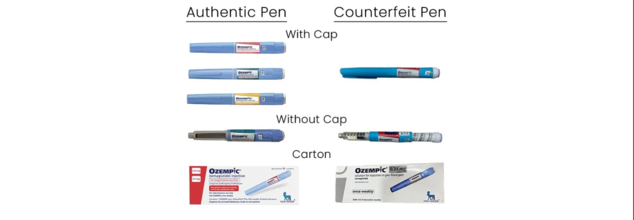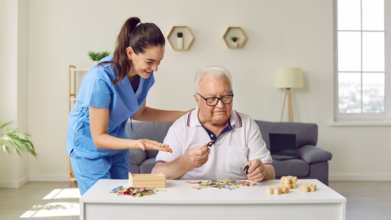- Health Conditions A-Z
- Health & Wellness
- Nutrition
- Fitness
- Health News
- Ayurveda
- Videos
- Medicine A-Z
- Parenting
- Web Stories
Could Your Ozempic Weight Loss Injection Be A Deadly FAKE Jab? Little-Known Signs To Spot

Image Credits: Govt of Virgin Islands
As demand for weight loss medications like Ozempic skyrockets globally, health officials are sounding the alarm: a surge of counterfeit jabs—often sold through unregulated online vendors and even beauty salons—are endangering lives. These fake injections are deceptively difficult to identify and, in many cases, could trigger life-threatening complications, including hypoglycemic shock, seizures, and even coma.
While these medications have revolutionized weight loss management for individuals with obesity and Type 2 diabetes, the black-market boom has opened the floodgates to dangerous look-alikes. Here’s everything you need to know about identifying fake Ozempic jabs, understanding their health risks, and ensuring you're accessing safe, approved treatment.
Ozempic (semaglutide) and its counterparts, Wegovy and Mounjaro (tirzepatide), are GLP-1 receptor agonists originally designed to help manage blood sugar levels in Type 2 diabetes patients. Their weight loss effects, however, made them blockbuster drugs—with users shedding up to 33 lbs in clinical trials.
Unsurprisingly, this popularity has given rise to a dangerous market of counterfeit versions. Criminal networks are capitalizing on demand by relabeling insulin pens, creating fake formulations in unsterile environments, and peddling them on platforms where regulation is minimal or absent.
Andy Morling of the UK’s Medicines and Healthcare products Regulatory Agency (MHRA) reports that fake jabs have been flooding the market since early 2023. Over 600 counterfeit Ozempic pens have been seized in the UK alone. “There’s no way of knowing what’s really inside them,” warns Morling. “They could be made with arsenic, cement, or even rat poison.”
How Dangerous Are Fake Ozempic Pens?
The short answer: extremely. The risks go far beyond inefficacy.
Some fake jabs contain:
Insulin – Can dangerously drop blood sugar, leading to seizures or coma.
Toxic substances – Seized products have been found to contain mercury, cement, and rat poison.
Bacteria – Due to non-sterile production environments, leading to infections.
Wrong or mixed medications – Including none of the intended drug at all.
Dr. Nick Kaye of the UK’s National Pharmacy Association has voiced concern about a potential explosion in black-market sales. “The supply of Ozempic is already tight. That, coupled with high demand, creates a perfect storm for counterfeiters.”
Telltale Signs Your Ozempic Is Fake
Identifying a counterfeit jab can be difficult without lab testing, but drug experts have noted some red flags:
Suspicious labeling: A genuine Ozempic pen comes with pre-printed, high-quality labeling—not stuck-on, crooked, or low-resolution stickers.
Dark or discolored pens: Most genuine pens are light in appearance and consistent in color.
Damaged packaging: Misspelled text, missing serial numbers, or unclear batch codes are warning signs.
Non-pen formats: Real Ozempic comes in pre-filled injector pens. If your product arrives in a syringe or vial from an online order, it’s almost certainly fake.
Sold on social media: Legitimate medications are never sold on Instagram, TikTok, or salon backrooms.
Still unsure? Check the batch number and barcode with the manufacturer or pharmacy.
Online vendors and salons may promise affordability and availability—but that’s where safety ends.
Unlike licensed pharmacies, these sources do not:
- Verify your BMI or medical history
- Provide guidance on correct dosage and administration
- Offer patient counseling or disclose side effects
- Follow FDA or international regulatory standards
Regulated services screen for medical appropriateness and ensure that the drugs have passed stringent safety tests. Using counterfeit jabs skips all of these safeguards.
If You Do not Qualify for the Treatment, How Can You Lose Weight?
If you don’t qualify for Ozempic or similar weight loss medications, it’s essential to explore safe alternatives rather than seeking out illicit versions. Healthy lifestyle changes remain foundational to weight management:
- Eat whole foods and reduce processed sugar
- Incorporate daily physical activity—150 minutes per week
- Avoid crash diets or over-the-counter supplements with unverified claims
- Speak with a doctor or dietitian for personalized support
For those with disordered eating patterns, reaching out to mental health professionals or organizations like Beat Eating Disorders can offer a healthier path.
When the Price Seems Too Good to Be True
It probably is. A major lure of counterfeit Ozempic is the price tag—black-market versions are often heavily discounted. But remember: this comes at the cost of your health, safety, and potentially, your life.
If you’re unsure about a product, consult your pharmacist or primary care provider. Always ensure that any medication you take has been prescribed by a qualified healthcare provider and obtained from a licensed source.
As the obesity epidemic collides with a global supply crunch, counterfeiters are betting on your desperation. Don’t fall for it. The allure of a quick fix should never outweigh the risks to your health.
Choose regulated, prescription-only weight loss treatments. Trust your pharmacist. Ask questions. And if something feels off, it probably is. Fake Ozempic isn’t just ineffective—it’s potentially lethal.
What Is The 'Asian Glow'? Is It Just Body's Reaction To Alcohol Or Something More Dangerous?

Credits: Canva
Commonly nicknamed the “Asian glow” or “Asian flush,” alcohol flush reaction is a physical response to drinking alcohol seen predominantly in people of East Asian descent.
This condition is marked by a reddening of the face, increased heart rate, and sometimes nausea or headaches shortly after consuming alcohol.
About 560 million people worldwide, which makes it roughly 8% of the global population, carry a genetic mutation called ALDH2*2 that causes this reaction. An estimated 45% of East Asians experience flushing when they drink, and many use antihistamines to mask the symptoms.
But researchers warn that these visible reactions are more than just a cosmetic issue, they’re a red flag indicating a heightened vulnerability to serious diseases.
What Causes It?
The root cause of alcohol flush reaction lies in how alcohol is metabolized in the body.
Normally, alcohol is broken down in two steps.
- First, it is converted into acetaldehyde, a compound far more toxic than alcohol itself.
- Then, acetaldehyde is quickly broken down into acetate by an enzyme called aldehyde dehydrogenase 2 (ALDH2), which the body can safely eliminate.
However, in people with the ALDH2*2 mutation, this second step is impaired. Their version of the ALDH2 enzyme has little to no activity, causing acetaldehyde to accumulate in the bloodstream. This toxic buildup is what leads to the flushing and other symptoms.
The World Health Organization classifies acetaldehyde as a Group 1 carcinogen, meaning there is strong evidence that it causes cancer in humans. Even with moderate alcohol intake—such as two beers, the acetaldehyde levels in people with this mutation can reach carcinogenic levels.
Why It’s Dangerous
While many consider alcohol flush reaction an inconvenience, the health risks it signals are far more serious. Experts have linked the ALDH2*2 mutation with significantly elevated risks for several life-threatening conditions if alcohol consumption continues.
People with the mutation who drink moderately (defined as two drinks per day for men and one for women) have a 40 to 80 times higher risk of developing esophageal cancer compared to those without the mutation. The risk increases with the amount of alcohol consumed, making it a dose-dependent danger.
The mutation is also associated with higher risks of:
- Head and neck cancers
- Gastric (stomach) cancer
- Coronary artery disease
- Stroke
- Osteoporosis
Importantly, these elevated health risks are not seen in non-drinkers with the same mutation, highlighting that alcohol intake is the trigger.
Why Antihistamines Don’t Help
Many young people, particularly college students, take over-the-counter antihistamines like Pepcid AC or Zantac to reduce the visible symptoms of alcohol flush reaction. While these drugs may lessen skin flushing by reducing blood vessel dilation, they do nothing to prevent the dangerous accumulation of acetaldehyde in the bloodstream.
Experts caution that using antihistamines this way is risky. By masking the body’s warning signals, individuals may end up drinking more than they should, unknowingly increasing their health risks.
A Problem of Awareness
Despite the potentially deadly consequences, awareness of the ALDH2*2 mutation remains low.
The variant is believed to have originated from a single individual in Southeast China 2,000 to 3,000 years ago. Today, its prevalence is highest in Taiwan (49 percent), Japan (40 percent), China (35 percent), and South Korea (30 percent). Yet, alcohol consumption in East Asia continues to rise.
Between 1990 and 2017, alcohol use in East Asia increased from 48.4 percent to 66.9 percent. The region now bears the highest burden of alcohol-attributable cancers globally, with 5.7 percent of all cancer cases linked to alcohol, nearly double the rate in North America.
Many people still believe that facial flushing from alcohol is harmless or even a sign of a strong liver. In fact, it’s a clear signal of toxicity and should not be ignored.
Raising Public Education and Health Literacy
Efforts to raise awareness are growing. In Taiwan, researchers and health advocates founded the Taiwan Alcohol Intolerance Education Society, which collaborates with government agencies to educate the public. The group launched National Taiwan No Alcohol Day on May 9, with “5-9” sounding like “no alcohol” in Mandarin, a clever linguistic nudge toward abstinence, as reported by the Washington Post.
Research also suggests that personalized health information can help. A study conducted among Asian American young adults found that those who were informed about their genetic risks related to the ALDH2*2 variant reduced both their drinking frequency and volume over the following month.
Experts emphasize that the message is clear: if you experience alcohol flush reaction, your body is sounding an alarm. Ignoring it may come at a serious cost.
New Alzheimer’s Treatment Reaches Target – Study Finds Insulin Delivered This Way Could Help

(Credit-Canva)
A disease that can strip somebody of their memories, the way they think, even their core beliefs and personality, Alzheimer’s affect millions of people throughout the world. It is estimated to affect 6 million Americans by the US National Institute of Aging, most of whom are older than 65 or older. While treatment for Alzheimer's does exist, they usually treat the symptoms as there is no cure.
However, a new study suggests that insulin delivered through a nasal spray could be a future treatment for Alzheimer's disease. Researchers found that this insulin effectively reached important memory parts of the brain in a small group of older adults. Their findings were published on July 23 in the journal Alzheimer’s & Dementia: Translational Research & Clinical Interventions.
Why Insulin for Alzheimer's?
Scientists are looking at insulin as a possible way to treat Alzheimer's because it's thought to improve brain activity. It's already known that insulin resistance (when the body doesn't respond well to insulin) is a risk factor for Alzheimer's. However, past research struggled to confirm if insulin given through the nose actually made it to the right places in the brain.
Direct Path to the Brain
They used brain scans to show that insulin given through the nose traveled to 11 key brain areas. These areas are important for memory and thinking. An interesting discovery was that people who were just starting to show signs of memory problems absorbed the insulin differently than others.
A lead researcher explained that this study fills a big gap in our understanding of how insulin given through the nose reaches the brain. This person also noted that finding different absorption rates in people with early memory issues was a surprise. This means scientists are no longer guessing; they now have a clear path or "roadmap" directly to the brain.
How the Study Was Done and What It Found
Researchers used brain scans on 16 older adults, who were about 72 years old on average. Seven of them had normal thinking skills, and nine had mild memory problems. All of them used the insulin nasal spray, and they said it was easy to use.
The scans clearly showed that insulin levels went up in important memory and thinking parts of the brain, like the hippocampus (which helps with memory), the amygdala (involved in emotions and memory), and other brain regions.
The study also found that people with healthy brains absorbed more insulin compared to those with mild memory issues. For women in the study, better heart health seemed to lead to better insulin absorption in the brain. On the other hand, individuals who had higher levels of a substance called amyloid beta (which is a sign of increased Alzheimer's risk) absorbed less insulin in many parts of their brain.
Only two people mentioned minor headaches after using the spray and getting their scan, which suggests the treatment is generally well-tolerated and doesn't cause many side effects.
Future Steps and Hope for Treatments
A lead researcher pointed out that one of the biggest challenges in treating brain diseases is getting medications to actually enter the brain. This study proves that they can now reliably check if nasal spray systems are delivering the medicine effectively. This is a very important step before they can start larger trials to test the treatment's effectiveness.
The findings also help explain why some patients might respond better to insulin given through the nose than others. The researcher stressed that there is an urgent need to find effective and easy ways to prevent and treat Alzheimer's. These results mean scientists now have the tools to confirm if treatments are reaching their intended brain targets, which is vital for designing successful studies.
The research team plans to conduct bigger studies within the next one to two years. They want to investigate other factors that might affect how insulin gets to the brain, such as the health of blood vessels, the presence of amyloid beta clumps, and differences between men and women. The researcher concluded by saying that while there's still a lot to learn, these findings are promising for creating more effective and easy-to-use treatments for Alzheimer's disease.
College Student Beats Breast Cancer By Lifting Through Recovery - How Active Recovery Helped Her Treatment

(Credit-Miller School of Medicine)
‘Fight through cancer’, ‘you can’t let cancer kick you down’ are things survivors and people who have had recent cancer diagnosis. While it is a good sentiment, one must understand that cancer is difficult a difficult process to go through. However, this young college student did not let this stop her.
LaShae Rolle, a 27-year-old competitive powerlifter, can squat a massive 441 pounds, bench press 292 pounds, and deadlift 497 pounds. Last year, breast cancer threatened her dreams of competing against the best. But Rolle didn't let it stop her. She powered through her cancer treatment, maintaining an intense strength training program all along. And then, she wrote a study about her experience.
Lifting Through Treatment
Rolle, who is studying public health sciences at the University of Miami, became the subject of her own unique study. She documented her journey of elite-level strength training while undergoing chemotherapy, a mastectomy (breast removal surgery), and radiation.
Her study, published in the journal Lifestyle Medicine, challenges the common belief that cancer patients should only do low or moderate exercise. Rolle explained that strength training was key to her identity as an athlete and researcher. During her cancer journey, it helped her feel connected to herself and in control of her body and mind.
By the end of her treatment, Rolle had managed to keep almost all the strength she had before her cancer diagnosis. She proudly stated that she kept going, adapting her workouts around her chemotherapy cycles to train safely. This physical activity gave her a sense of normalcy when everything else felt uncertain.
Why This Research Matters
Previous studies have shown that moderate exercise can help cancer patients by reducing tiredness, improving physical ability, and easing treatment side effects. However, that research usually focused on average people doing regular workouts, not elite athletes trying to maintain high-intensity efforts during treatment.
In the Miller School of Medicine news release, Tracy Crane, a director at the University of Miami's Sylvester Comprehensive Cancer Center and Rolle's mentor, emphasized that Rolle's story is a powerful reminder that recovery from cancer isn't just about getting better; it's about regaining strength, identity, and purpose. She added that Rolle's commitment to powerlifting shows how movement can be a way to heal, empower, and advocate for oneself.
Rolle's Training Plan and Impressive Results
Rolle was diagnosed with stage 2B breast cancer in 2024. Her cancer was fueled by female hormones, and she didn't have a genetic link to the disease. Her colleagues at the University of Miami helped her create a strength training plan that fit around her chemotherapy schedule:
- High-intensity days were planned before her chemo sessions, focusing on squats, bench press, and deadlifts.
- Moderate days between chemo cycles included exercises like rows and shoulder presses.
- Recovery days immediately after chemo involved light movement and therapy.
By the end of her treatment, Rolle had retained an incredible 93% of her squat strength and 87% of her bench press and deadlift strength. These are remarkable numbers for someone going through chemotherapy. Rolle kept herself accountable by documenting everything with videos and in a training diary, which reminded her of her ongoing strength. She expressed amazement looking back at videos of herself lifting over 400 pounds while on chemotherapy.
Researchers note that these specific findings mainly apply to elite athletes who already have a background in high-intensity training, rather than the average cancer patient. However, Rolle believes her study highlights the importance of creating treatment plans tailored to each patient's needs. She is motivated to continue lifting and to advocate for evidence-based exercise as a key part of cancer care.
© 2024 Bennett, Coleman & Company Limited



